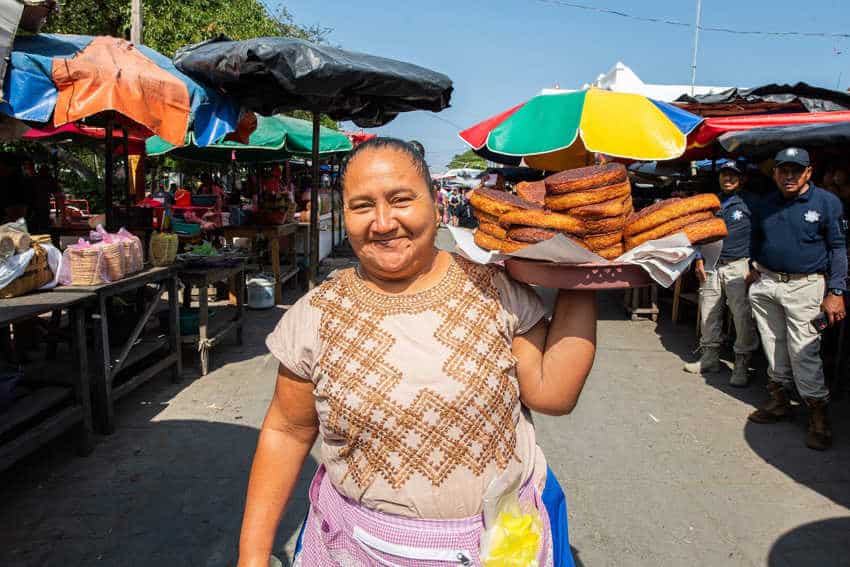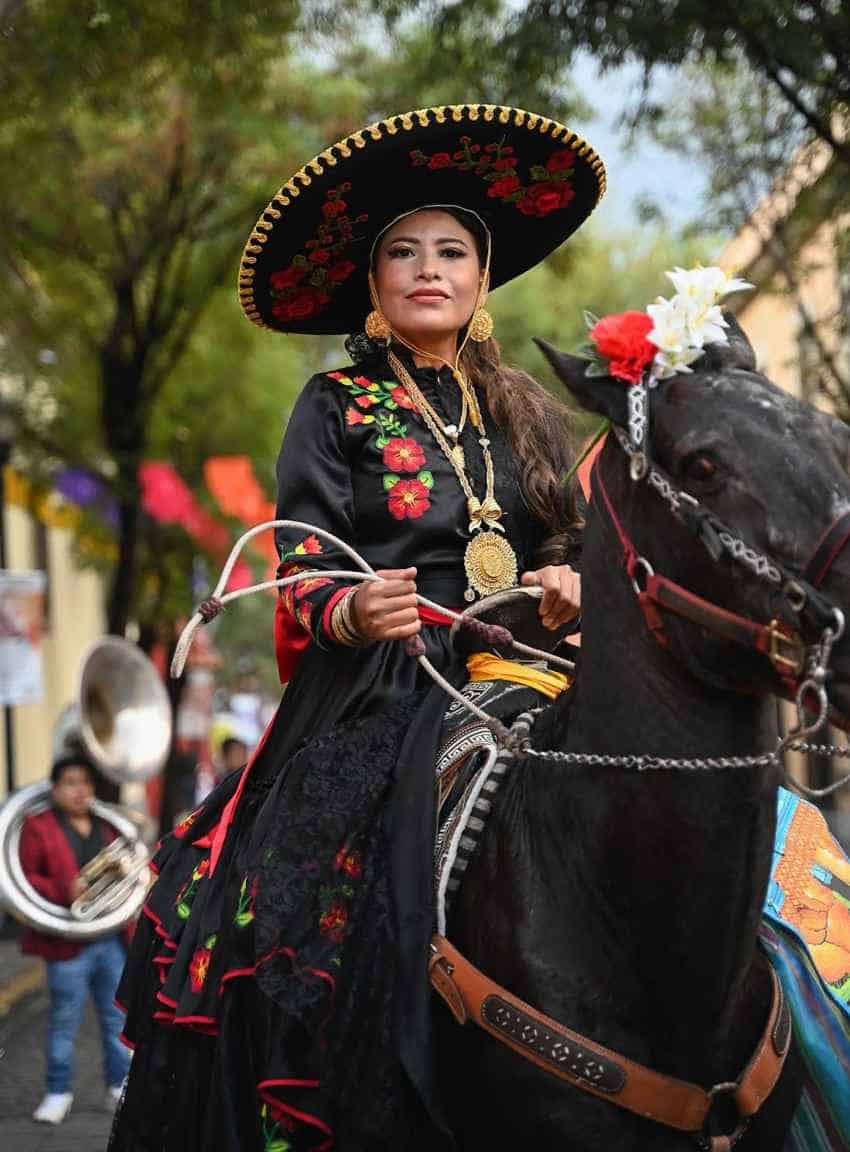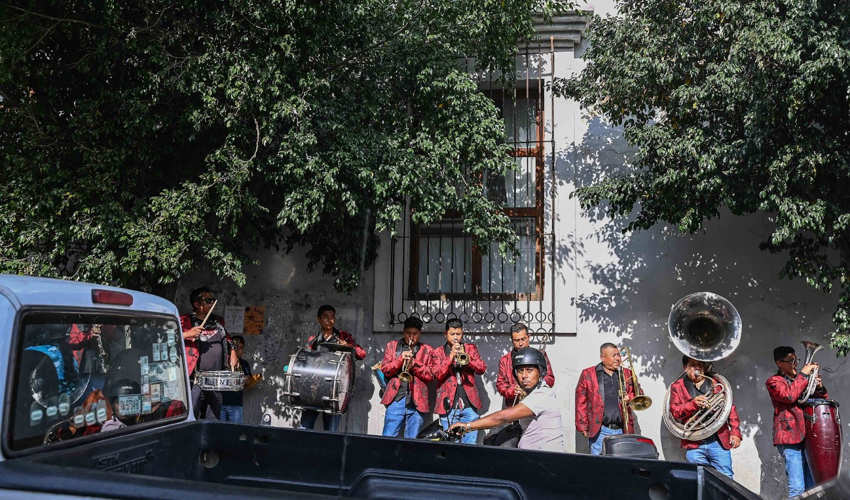This year, celebrations for Oaxaca city’s annual Vela de Xhavizende — an annual multi-day event that celebrates the culture of the Indigenous people of Juchitán, Oaxaca, and their patron saint, St. Vincente Ferrer — opened Wednesday, featuring the traditional mass in celebration of the patron saint, followed by the colorful regada, a procession in which riders on horseback move through the streets of Oaxaca city throwing sweets and trinkets into the crowds, and ending this weekend with a gala vela event, as well as the traditional washing of the pots that cooked the food for the gala.
These types of celebrations are common throughout Oaxaca; just about every community has its own variant on the event, a syncretic festival that mixes the veneration of a Catholic patron saint with pre-conquest Indigenous traditions. This one in particular, the Vela de Xhavizende, originated nearly 200 kilometers away from Oaxaca city in Juchitán de Zaragoza, an eastern Oaxaca city of about 113,000, according to 2020 federal numbers.

The Vela de Xhavizende is meant to celebrate a 14th-century saint from Valencia, Spain, and also to bring good luck for the annual harvest. But what it’s also doing for this far-flung Oaxaca city community of Juchitecos, as they are called, is preserving their cultural heritage and sense of unity far from their original home.
Over the last several decades, Juchitecos who arrived looking for better work and educational opportunities have become a significant diaspora in Oaxaca city. Some estimates put them at about 10,000.
This celebration, which has taken place in Oaxaca city for over 35 years, is stewarded by the Association of Juchitecos Radicados en Oaxaca (Association of Juchitecos Living in Oaxaca). According to this year’s regada lead rider, Capitana María Sabina López Charis, her role as the “capitana” (captain) symbolizes “faith and celebration” as she leads her riders through the city’s streets.
López’s mother Nereyda is part of the association of stewards that organizes the festivities each year, and Nereyda and her daughters own Casa Juchitán, a Oaxaca city restaurant that champions traditional Istmeño food.
As I joined them for the mass and the regada this past week, López and her mother set aside a beautiful outfit for me, made up of an embroidered huipil, skirt, petticoat and gold filigree jewelry. López did my hair in braids and added flowers, which typically go with this style of dress. This is typical of Juchiteco celebrations, where everyone attending wears traditional attire.
The family and friends getting ready at Casa Juchitán were given food and drink, including Juchiteco classics such as garnachas: mini tortillas fried in oil and served with tomato sauce, ground beef and chopped onion, sprinkled with dry, white cheese. A group of men (and a couple of younger boys) with their big brass instruments packed into the small restaurant to get food and big cups of fruit water (agua del día) and played as we made our final touches to our outfits.

At 3:30 p.m., López mounted a black horse brought to the front of the restaurant, and we began the walk through the city towards Our Lady of Guadalupe church in El Llano park. Upon arriving, our group was joined by other Juchitecas in beautiful, vibrant dresses. The church was full, and the priest gave a dynamic, uplifting mass in honor of the patron saint. He blessed the residents of Juchitán and those who had organized the festivities. After the mass, the whole community gathered behind López to begin the regada.
In Juchitán, regadas have roots in pagan ritual. In the original versions of the event, besides the fruits thrown into the crowd, there were also ox-drawn carts carrying people, gifts and a “queen” of the vela. This sharing of wealth was thought to bring good luck for the next harvest.
Vico Peralta, a member of the association of Juchitecos, explained.
“They are gifts for nature,” he said. “Before, they used only fruits that came from the region, and the inhabitants returned the gift to the earth, giving away their fruits. This was before the arrival of the Spanish. After the conquest, they converted to Catholicism, and, now, apart from honoring Mother Nature, they also honor St. Vincent Ferrer.”
These days, carts are replaced by trucks, and the gifts thrown are things like plastic bowls, keychains and sweets.
We walked southward from the church for several blocks before turning right on Calle Mariano Abasolo, heading towards the Alcala pedestrian thoroughfare. With each block, the streets became more packed, with people crowding the sidewalk to get a glimpse — and perhaps get their hands on some gifts being thrown.

By the time we reached the Templo de Santo Domingo church, the crowd completely overwhelmed us, partly because the regada coincided with the arrival of calendas — processions of musicians and dancers.
Once the regada made it through, a small group with the band headed back to Casa Juchitán — where López and her family hosted a more intimate party late into the night.
Anna Bruce is an award-winning British photojournalist based in Oaxaca, Mexico. Just some of the media outlets she has worked with include Vice, The Financial Times, Time Out, Huffington Post, The Times of London, the BBC and Sony TV. Find out more about her work at her website or visit her on social media on Instagram or on Facebook.
